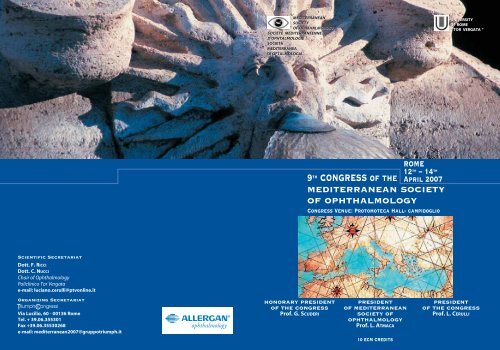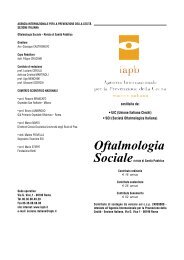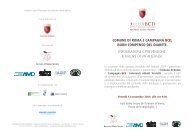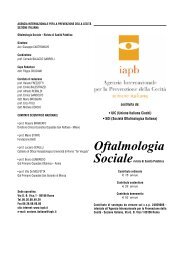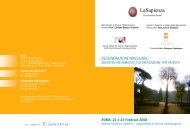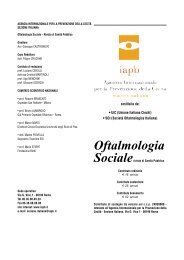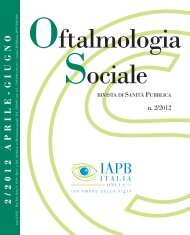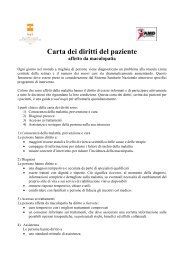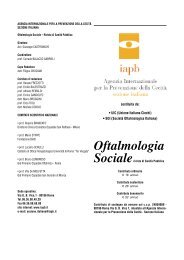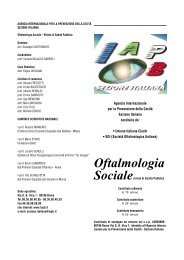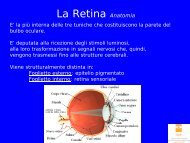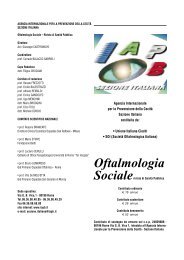9th CONGRESS of the
9th CONGRESS of the
9th CONGRESS of the
You also want an ePaper? Increase the reach of your titles
YUMPU automatically turns print PDFs into web optimized ePapers that Google loves.
www.cocchistampa.net<br />
MEDITERRANEAN<br />
SOCIETY<br />
OF OPHTHALMOLOGY<br />
SOCIÉTÉ MÉDITERRANÉENNE<br />
D'OPHTALMOLOGIE<br />
SOCIETÀ<br />
MEDITERRANEA<br />
DI OFTALMOLOGIA<br />
UNIVERSITY<br />
OF ROME<br />
“ TOR VERGATA “<br />
ROME<br />
12<br />
9 th <strong>CONGRESS</strong> <strong>of</strong> <strong>the</strong><br />
th – 14<br />
April 2007<br />
th<br />
MEDITERRANEAN SOCIETY<br />
OF OPHTHALMOLOGY<br />
Congress Venue: Protomoteca Hall- campidoglio<br />
Scientific Secretariat<br />
Dott. F. RICCI<br />
Dott. C. NUCCI<br />
Chair <strong>of</strong> Ophthalmology<br />
Policlinico Tor Vergata<br />
e-mail: luciano.cerulli@ptvonline.it<br />
Organizing Secretariat<br />
Via Lucilio, 60 - 00136 Rome<br />
Tel. + 39.06.355301<br />
Fax +39.06.35530268<br />
e-mail: mediterranean2007@gruppotriumph.it<br />
ophthalmology<br />
HONORARY PRESIDENT<br />
OF THE <strong>CONGRESS</strong><br />
Pr<strong>of</strong>. G. SCUDERI<br />
PRESIDENT<br />
OF MEDITERRANEAN<br />
SOCIETY OF<br />
OPHTHALMOLOGY<br />
Pr<strong>of</strong>. L. ATMACA<br />
10 ECM CREDITS<br />
PRESIDENT<br />
OF THE <strong>CONGRESS</strong><br />
Pr<strong>of</strong>. L. CERULLI
PRESIDENTIAL ADDRESS<br />
The Mediterranean Society <strong>of</strong> Ophthalmology has always been a meeting<br />
point for eminent ophthalmologists with different backgrounds and diverse<br />
historical and cultural roots. In <strong>the</strong> spirit <strong>of</strong> friendship and collaboration that is traditional<br />
in this Society, I am pleased and honored to welcome all <strong>of</strong> you – speakers<br />
and participants alike – to <strong>the</strong> historical city <strong>of</strong> Rome, which has been famed for<br />
centuries as a cross-roads for different civilizations and cultures.<br />
The topics we will be analyzing during this meeting are related to <strong>the</strong> principal causes<br />
<strong>of</strong> blindness and low vision in <strong>the</strong> world, and while <strong>the</strong> presentations we will be<br />
hearing will undoubtedly increase our knowledge, our hope is that <strong>the</strong>y will also<br />
allow us to provide our patients with better, more effective healthcare, including<br />
<strong>the</strong> human support that is such an integral part <strong>of</strong> healing.<br />
My special thanks to <strong>the</strong> speakers who have so generously agreed to share <strong>the</strong>ir<br />
experiences with us. Some have travelled long distances to be with us today. We<br />
are also grateful for <strong>the</strong> generosity <strong>of</strong> our sponsors, who – in spite <strong>of</strong> <strong>the</strong> difficult<br />
times – have contributed so generously toward <strong>the</strong> realization <strong>of</strong> this Congress.<br />
With spring in <strong>the</strong> air, Rome is at its loveliest, and I hope all <strong>of</strong> you will enjoy your<br />
stays here in <strong>the</strong> heart <strong>of</strong> <strong>the</strong> Eternal City.<br />
With best wishes,<br />
Pr<strong>of</strong>. Luciano Cerulli<br />
1
MEDITERRANEAN SOCIETY OF OPHTHALMOLOGY<br />
PROGRAM<br />
THURSDAY 12 TH APRIL 2007<br />
Main Room<br />
15,00 – 17,00 Meeting <strong>of</strong> <strong>the</strong> Board - Mediterranean Society <strong>of</strong> Ophthalmology<br />
17,00 – 18,00 Opening ceremony<br />
18,00 – 18,30 AWARD LECTURE – Uveitis in <strong>the</strong> Mediterranean area: Behçet’s Disease<br />
L. Atmaca (Turkey)<br />
18,30 – 19,00 AWARD LECTURE – Recent <strong>the</strong>rapeutic strategies and follow up for exudative acquired<br />
macular degeneration<br />
G. Coscas (France)<br />
19,00 Visit to “Capitolini” Museum<br />
20,00 Welcome cocktail at <strong>the</strong> “Caffarelli” Terrace<br />
FRIDAY 13 TH APRIL 2007<br />
Main Room<br />
08,30 – 09,30 GLAUCOMA: UPDATE ON THERAPY<br />
Moderators: M.G. Bucci, D. Ben Ezra<br />
08,30 – 08,45 Medical Treatment: <strong>the</strong> issues from <strong>the</strong> European Glaucoma Society C. Sborgia (Italy)<br />
08,45 – 09,00 Modern Aqueous Shunt Implantation – Future Challenges K. Barton (U.K.)<br />
09,00 – 09,10 Selective laser trabeculoplasty G.L. Scuderi (Italy)<br />
09,10 – 09,20 Improving results <strong>of</strong> glaucoma surgery R. Carassa (Italy)<br />
09,20 – 09,30 Management <strong>of</strong> failing blebs after filtering surgery A. Ouertani (Tunisia)<br />
09,30 – 10,30 GLAUCOMA: UPDATE ON DIAGNOSIS<br />
Moderators: A. Ouertani, C. Sborgia<br />
09,30 – 09,45 Glaucoma risk factors documented in clinical trials G. Manni (Italy)<br />
09,45 – 10,00 Early diagnosis in glaucoma K. Andac (Turkey)<br />
10,00 – 10,15 Monitoring glaucoma progression P. Brusini (Italy)<br />
10,15 – 10,30 Pediatric cataract and glaucoma D. Ben Ezra (Israel)<br />
10,30 – 11,00 COFFEE BREAK<br />
11,00 – 12,15 NEUROPROTECTION: THE MECHANISMS OF NEURONAL DAMAGE IN GLAUCOMA<br />
Scientifically supported by <strong>the</strong> Neuroprotection Interdisciplinary Group<br />
Moderators: G. Bagetta, N.N. Osborne<br />
11,00 – 11,15 Retinal ischemia induces retinal ganglion cell (RGC) loss and alters retrograde and<br />
orthograde axonal transport in surviving RGCs: neuroprotective effects <strong>of</strong> alpha-2<br />
adrenergic agonists<br />
M. Vidal Sanz (Spain)<br />
11,15 – 11,30 Oxidative stress and retinal ganglion cell death in glaucoma N.N. Osborne (UK)<br />
11,30 – 11,45 The role <strong>of</strong> <strong>the</strong> excitotoxic cascade M.F. Cordeiro (UK)<br />
11,45 – 12,00 The role <strong>of</strong> <strong>the</strong> immune system M. Schwartz (Israel)<br />
12,00 – 12,15 Involvment <strong>of</strong> <strong>the</strong> endocannabinoid system in retinal ganglion cell death:<br />
implications for neuroprotection in glaucoma<br />
C. Nucci (Italy)<br />
FRIDAY 13 TH APRIL 2007<br />
Main Room<br />
12,20 – 13,00 NEUROPROTECTION: THE AVAILABLE TREATMENT<br />
Scientifically supported by <strong>the</strong> Neuroprotection Interdisciplinary Group<br />
Moderators: G. Carella, M.F. Cordeiro<br />
12,20 – 12,30 Citicoline V. Parisi (Italy)<br />
12,30 – 12,40 Memantine S. Gandolfi (Italy)<br />
12,40 – 12,50 Neurochemical and neuropathological features <strong>of</strong> retinal<br />
excitotoxicity associated with experimental glaucoma<br />
is minimized by Coenzyme Q10<br />
R. Russo (Italy)<br />
12,50 – 13,00 Epigallocatechin gallate M. Vetrugno (Italy)<br />
13,00 – 13,30 Discussion<br />
13,30 – 14,30 LUNCH<br />
14,30 – 16,00 UPDATE ON TREATMENT OF DIABETIC RETINOPATHY<br />
AND VENOUS OCCLUSIVE DISEASE<br />
Moderators: G. Coscas, B. Lumbroso<br />
14,30 – 14,40 Is laser treatment <strong>of</strong> diabetic macular oedema still indicated R. Brancato (Italy)<br />
14,40 – 14,50 Combined <strong>the</strong>rapy: laser and IVTA in CSME L. Atmaca (Turkey)<br />
14,50 – 15,00 Intra-vitreal steroids in <strong>the</strong> treatment <strong>of</strong> diabetic retinopathy :<br />
only a symptomatic <strong>the</strong>rapy<br />
15,00 – 15,10 Juxtascleral posterior infusion <strong>of</strong> a modified formulation<br />
<strong>of</strong> triamcinolone acetonide for <strong>the</strong> treatment<br />
<strong>of</strong> diabetic macular oedema<br />
J. Jonas (Germany)<br />
P. Lanzetta (Italy)<br />
15,10 – 15,20 VEGF inhibitors in <strong>the</strong> treatment <strong>of</strong> CSME U. Introini (Italy)<br />
15,20 – 15,30 Combined <strong>the</strong>rapy: laser and IVTA in PDR F. Bandello (Italy)<br />
15,30 – 15,40 VEGF inhibitors in <strong>the</strong> treatment <strong>of</strong> PDR A. Pece (Italy)<br />
15,40 – 15,50 VEGF inhibitors in <strong>the</strong> <strong>the</strong>rapy <strong>of</strong> macular oedema secondary<br />
to venous occlusive disease.<br />
15,50 – 16,00 May IVTA enhance <strong>the</strong> outcome <strong>of</strong> <strong>the</strong> surgical<br />
treatment <strong>of</strong> diffuse DME<br />
16,00 – 16,30 COFFEE BREAK<br />
G. Staurenghi (Italy)<br />
G. Lesnoni; L. Colecchia (Italy)<br />
16,30 – 17,40 UPDATE ON PHARMACOLOGICAL THERAPY <strong>of</strong> Macular Diseases /<br />
CNV / Chronic Epi<strong>the</strong>liopathy / Inflammatory disease (I)<br />
Moderators: J. Jonas, F. Bandello<br />
16,30 – 16,40 The actual role <strong>of</strong> PDT-V in <strong>the</strong> treatment <strong>of</strong> WET AMD M. Varano (Italy)<br />
16,40 – 16,50 Pegaptanib (Macugen) in <strong>the</strong> treatment <strong>of</strong> WET AMD U. Introini (Italy)<br />
16,50 – 17,00 Ranibizumab (Lucentis) in <strong>the</strong> treatment <strong>of</strong> WET AMD U. Menchini (Italy)<br />
17,00 – 17,10 Is <strong>the</strong>re room for Bevacizumab (Avastin)<br />
in <strong>the</strong> treatment <strong>of</strong> Wet AMD<br />
A. Giovannini (Italy)<br />
2<br />
3
MEDITERRANEAN SOCIETY OF OPHTHALMOLOGY<br />
PROGRAM<br />
FRIDAY 13 TH APRIL 2007<br />
Main Room<br />
17,10 – 17,20 Combined <strong>the</strong>rapy: intravitreal triamcinolone and photodynamic <strong>the</strong>rapy<br />
for <strong>the</strong> treatment <strong>of</strong> choroidal neovascularization<br />
in age-related macular degeneration<br />
J. Jonas (Germany)<br />
17,20 – 17,30 Combined <strong>the</strong>rapy: intravitreal ranibizumab (lucentis) and PDT-V for <strong>the</strong> treatment <strong>of</strong> choroidal<br />
neovascularization in age-related macular degeneration<br />
M. Tsilimbaris (Greece)<br />
17,30 – 17,40 Combined <strong>the</strong>rapy: triple <strong>the</strong>rapy A. Augustin (Germany)<br />
17,40 – 18,55 UPDATE ON PHARMACOLOGICAL THERAPY <strong>of</strong> Macular Diseases /<br />
CNV / Chronic Epi<strong>the</strong>liopathy / Inflammatory disease (II)<br />
Moderators: R. Brancato, U. Menchini<br />
17,40 – 17,50 RAP and age related maculopathy R. Axer Siegel (Israel)<br />
17,50 – 18,00 Therapeutic options in <strong>the</strong> management <strong>of</strong> RAP F. Bottoni (Italy)<br />
18,00 – 18,10 Therapeutic options for CNV secondary to inflammatory<br />
chorioretinal disease<br />
18,10 – 18,20 Polypoidal choroidal vasculopathy: angiographic<br />
characterization and <strong>the</strong>rapeutic options.<br />
M. Battaglia Parodi (Italy)<br />
S. Piermarocchi (Italy)<br />
18,20 – 18,35 Cost-benefits ratio <strong>of</strong> actual and ongoing <strong>the</strong>rapies <strong>of</strong> AMD G. Virgili (Italy)<br />
18,35– 18,45 Therapeutic options for diffuse retinal pigment epi<strong>the</strong>liopathy<br />
and chronic central serous chorioretinopathy<br />
F. Cardillo Piccolino (Italy)<br />
18,45– 18,55 The white dots syndromes: differential diagnoses and <strong>the</strong>rapy D. Ben Ezra (Israel)<br />
19,00 – 19,30 Test for Continuing Medical Education<br />
08,30 – 13,00 RETINA COURSES<br />
Courses in Room A<br />
08,30 – 10,30 BASIC DIAGNOSTIC PROCEDURES IN AMD PATIENTS<br />
Moderators: A. Pece, U. Introini, F. Ricci<br />
08,30 – 08,45 Kinetic confocal angiography with HRA2 G. Fasolino (Italy)<br />
08,45 – 09,00 HRA2 : <strong>the</strong> ART <strong>of</strong> angiography F. Ricci (Italy)<br />
09,00 – 09,15 Spectralis HRA+OCT<br />
Simultaneous Spectral Domain OCT and Angiography<br />
G. Staurenghi (Italy)<br />
09,15 – 09,30 Abnormal Fundus Aut<strong>of</strong>luorescence in AMD Patients A. M. Minnella (Italy)<br />
09,30 – 09,45 OCT in diagnosis and follow-up <strong>of</strong> AMD B. Lumbroso (Italy)<br />
09,45 – 10,00 Microperimetry in AMD M. Cesareo (Italy)<br />
10,00 – 10,15 Exudative age-related macular degeneration and submacular<br />
hemorrhage: <strong>the</strong> role <strong>of</strong> <strong>the</strong> echography<br />
10,15 - 10,30 Correlation between microperimetry and optical coherence<br />
tomography findings<br />
10,30 – 11,00 COFFEE BREAK<br />
C. Tamburelli (Italy)<br />
E. Midena (Italy)<br />
FRIDAY 13 TH APRIL 2007<br />
Courses in Room A<br />
11,00 – 12,45 ACTUAL AND ONGOING THERAPIES OF AMD<br />
Moderators: E. Midena, G. Staurenghi, C. Tamburelli<br />
11,00 – 11,15 Indications for PDT-V V. Gasparri (Italy)<br />
11,15 – 11,30 Indications for VEGF inhibitors U. Introini (Italy)<br />
11,30 – 11,45 Combined <strong>the</strong>rapy : rationale and timing A. Pece (Italy)<br />
11,45 – 12,00 How to perform an intravitreal <strong>the</strong>rapy F. Ricci (Italy)<br />
12,00 – 12,15 Management <strong>of</strong> <strong>the</strong> infective complications A. Cusumano (Italy)<br />
12,15 – 13,00 Clinical cases panel<br />
13,00 – 13,30 Discussion<br />
13,30 – 14,30 LUNCH<br />
14,30 – 17,00 GLAUCOMA COURSE<br />
MORPHOLOGICAL AND FUNCTIONAL MONITORING IN GLAUCOMA<br />
Moderators: S. Gandolfi, G.L. Scuderi<br />
14,30 – 14,45 Qualitative evaluation <strong>of</strong> <strong>the</strong> optic nerve head M.G. Uva (Italy)<br />
14,45 – 15,00 Standard automated perimetry M. Cesareo (Italy)<br />
15,00 – 15,15 Frequency doubling technology perimetry<br />
in <strong>the</strong> diagnosis <strong>of</strong> glaucoma<br />
P. Brusini (Italy)<br />
15,15 – 15,30 Blue-yellow perimetry L. Rossetti (Italy)<br />
15,30 – 15,45 Algorithms for monitoring progression A. Perdicchi (Italy)<br />
15,45 – 16,00 GDxvcc M. Cent<strong>of</strong>anti (Italy)<br />
16,00 – 16,15 HRT F. Oddone (Italy)<br />
16,15 – 16,30 OCT in glaucoma management M. Pagliara (Italy)<br />
16,30 – 16,45 Functional laser doppler flowmetry: physiological aspects<br />
and clinical applications<br />
16,45 – 17,00 Discussion<br />
SATURDAY 14 TH APRIL 2007<br />
Main Room<br />
B. Falsini (Italy)<br />
08,30 – 10,30 SYMPOSIUM: From <strong>the</strong> product concept to <strong>the</strong> pharmaceutical development<br />
Moderators: S.M. Recupero, A. Missiroli<br />
Physiopathology <strong>of</strong> corneal wound healing<br />
D. Giammaria (Italy)<br />
The current <strong>the</strong>rapeutical approach: pros, cons and needs<br />
M. Rolando (Italy)<br />
From <strong>the</strong> idea to <strong>the</strong> product<br />
M. G. Mazzone (Italy)<br />
Biopolimers and cellular signalling<br />
G. Milazzo (Italy)<br />
4<br />
5
MEDITERRANEAN SOCIETY OF OPHTHALMOLOGY<br />
PROGRAM<br />
SATURDAY 14 TH APRIL 2007<br />
10,30 – 11,00 COFFEE BREAK<br />
Main Room<br />
11,00 – 13,00 SYMPOSIUM: “CONTROVERSY IN THE SURGERY OF LACRIMAL SYSTEM ”<br />
Moderators: G. Boccassini, G. Bonavolontà<br />
11,00 – 11,15 Anatomy <strong>of</strong> <strong>the</strong> lacrimal apparatus A. Ducasse (France)<br />
11,15 – 11,30 The role <strong>of</strong> endoscopy in diagnosis and <strong>the</strong>rapy F. Bruno (France)<br />
11,30 – 11,45 New technique for lacrimal system intubation F. Serra (France)<br />
11,45 – 12,00 Lacrimal system and orbital diseases G. Bonavolontà (Italy)<br />
12,00 – 12,15 The injuries <strong>of</strong> <strong>the</strong> lacrimal apparatus J. Lagier (France)<br />
12,15 – 12,30 Traditional external dacryocystorhinostomy<br />
versus intranasal approaches<br />
12,30 – 13,00 Discussion<br />
13,00 – 14,00 LUNCH<br />
R. Mancino (Italy)<br />
14,00 – 16,00 OCULAR SURGERY: ANTERIOR SEGMENT - CORNEA<br />
Moderators: E. Balestrazzi, C. Balacco Gabrieli<br />
14,00 – 14,15 Amniotic membrane in eye surgery S. Ayed (France)<br />
14,15 – 14,30 Innovations in refractive surgery M. Kamoun (Tunisia)<br />
14,30 – 14,45 The treatment <strong>of</strong> pain after prk G. La Tegola (Italy)<br />
14,45 – 15,00 Advanced in corneal graft surgery V. Maurino (UK)<br />
15,00 – 15,15 Electrotransfer for prevention <strong>of</strong> graft rejection in complicated cases D. Ben Ezra (Israel)<br />
15,15 – 15,30 Cross linking in <strong>the</strong> <strong>the</strong>rapy <strong>of</strong> cheratoconus A. Caporossi (Italy)<br />
15,30 – 15,40 The <strong>the</strong>rapeutic use <strong>of</strong> steroid/antibiotic combinations in clinical<br />
and surgical ophthalmology.<br />
C. Bianchi (Italy)<br />
15,40- 16.00 Innovation in farmaco<strong>the</strong>rapy - new steroid/antibiotic combination:<br />
- formulative aspects;<br />
- pharmacokinetics and microbiological activity. M.G. Mazzone, A.R. Blanco (Italy)<br />
16,00 – 16,30 COFFEE BREAK<br />
16,30 – 18,30 ROUND TABLE ON OCULAR SURGERY: POSTERIOR SEGMENT<br />
Moderators: C. Villani, M. Nouri<br />
16,30 – 17,00 Award Lecture – Pathogenesis and treatment<br />
<strong>of</strong> macular hole in <strong>the</strong> high myopic eye<br />
M. Stirpe (Italy)<br />
17,00 – 17,15 Sutureless vitrectomy:23 and 25 gauge transconjunctival systems M. Oncel (Turkey)<br />
17,15 – 17,30 Advances in retinal detachment surgery M. Nouri (Algeria)<br />
17,30 – 17,45 Tractional retinal detachment in diabetic retinopathy R. Rekik (Tunisia)<br />
17,45 – 18,00 Heavy silicone oil in <strong>the</strong> treatment <strong>of</strong> complicated retinal detachment M. Oncel (Turkey)<br />
Room A<br />
08,30 – 10,30 Round Table on Prevention <strong>of</strong> Blindness, Low Vision, Visual Rehabilitation with<br />
support <strong>of</strong> italian section <strong>of</strong> IAPB.<br />
Session I<br />
■ PRESIDENT OF HONOUR: G. Castronovo (Italy)<br />
10,30 – 11,00 COFFEE BREAK<br />
■ CHAIRMAN: Prince Ahmed Abdulaziz (Saudi Arabia)<br />
■ CO CHAIR: A. Trabelsi (Tunisia), B. Lumbroso (Italy)<br />
■ SPEAKERS: L. Cerulli (Italy), A. Ouertani, S. Ayed, F. Hediah (Tunisia), A. Amar, Nouri,<br />
Timsiline (Algeria), C. Corbè (France), K. Zaghloul (Morocco), Rais (Morocco), Fituri<br />
(Lybia), C. SidiSidi (Maurwtania) A. Pece, R. Crouzet Barbati, P. Vadalà (Italy) S. (Mariotti<br />
WHO) O<strong>the</strong>r speakers, P. Iorio, C. Martinoli, M. Schmidt, E. Tedeschi, R. De Giuli<br />
11,00 – 12,00 Round Table on Prevention <strong>of</strong> Blindness, Low Vision, Visual Rehabilitation with<br />
support <strong>of</strong> italian section <strong>of</strong> IAPB.<br />
Session II<br />
■ PRESIDENT OF HONOUR: G. Castronovo (Italy).<br />
■ CHAIRMAN: Prince Ahmed Abdulaziz (Saudi Arabia)<br />
■ CO CHAIR: A. Trabelsi (Tunisia), B. Lumbroso (Italy).<br />
■ SPEAKERS: L. Cerulli (Italy), A. Ouertani, S. Ayed, F. Hediah (Tunisia), A. Amar, Nouri,<br />
Timsiline (Algeria), C. Corbè (France), K. Zaghloul (Morocco), Rais (Morocco), Fituri<br />
(Lybia), C. SidiSidi (Maurwtania) A. Pece, R. Crouzet Barbati, P. Vadalà (Italy) S. Mariotti<br />
(WHO) O<strong>the</strong>r speakers, P. Iorio, C. Martinoli, M. Schmidt<br />
12,00 – 13,00 Meeting <strong>of</strong> <strong>the</strong> Task force for Low Vision (West Mediterranean)<br />
■ PRESIDENT OF HONOUR: G. Castronovo (Italy)<br />
13,00 – 14,00 LUNCH<br />
■ CHAIRMAN: B. Lumbroso<br />
■ CO CHAIR: A. Trabelsi (Tunisia)<br />
■ GENERAL SECRETARY: L. Cerulli<br />
■ SCIENTIFIC COMMITTEE: A.Ouertani (Tunisia), C. Corbè (France)<br />
■ MEMBERS: S. Ayed (Tunisia), A. Ailem, Nouri, Timsiline (Algeria), K. Zaghloul, (Morocco),<br />
Fituri (Lybia), C. SidiSidi (Mauretania) A. Pece, R. Barbati Crouzet (Italy), P. Aragona, P.<br />
Vadalà (Italy)<br />
■ SECRETARIAT COMMITTEE: Rais (Morocco), F. Hediah (Tunisia), P. Vadalà (Italy)<br />
14,00 – 16,00 Course: The new OCTs<br />
Lumbroso B. (Italy)<br />
18,30 – 19,00 Test for Continuing Medical Education<br />
6<br />
7
MEDITERRANEAN SOCIETY OF OPHTHALMOLOGY<br />
PROGRAM<br />
SOCIETE MEDITERRANEENNE D’OPHTALMOLOGIE BOARD<br />
SPEAKERS AND MODERATORS<br />
INTERNATIONAL MEDITERRANEAN OPHTALMOLOGICAL SOCIETY BOARD<br />
President<br />
L. Amaca (Turkey)<br />
President elect L. Ceruli (Italy)<br />
Presidents <strong>of</strong> Honor G. Scuderi (Italy), G. Coscas (France)<br />
Past Presidents T. Daghfous (Tunisia), S. Ayed (Tunisia), D. Ben Ezra (Israel), J. Alio (Spain)<br />
Vice Presidents M.T. Nouri (Algeria), R. Brancato (Italy)<br />
General Secretary B. Lumbroso (Italy)<br />
Deputy Secretary L. Ceruli (Italy)<br />
Scientific Advisers D. Hartani (Algeria), M. Kamoun (Tunisia), A.L. Siam (Egypt), G. Soubrane<br />
(France), K. Zaghloul (Morocco)<br />
Board Members Aliem Amar (Algeria), A. Amraoui (Morocco), Akram S. Matter (Palestine<br />
Authority), C. Balacco Gabrieli (Italy), J. Barraquer (Spain), G. Bonavolontà (Italy),<br />
M. Djennas (Algeria), L. El Matri (Tunisia), B. Jovicevic (Yugoslavia), C. Kanawati<br />
(Palestine Authority), M. Khairallah (Tunisia), S. Latinovic (Yugoslavia), R.<br />
Mabrouk (Tunisia), Magid Ramadam (Palestine Authority), I. Milli Boussen<br />
(Tunisia), A. Ouertani (Tunisia), M. Rafi (Morocco), G.L. Scuderi (Italy), Suad El<br />
Fituri (Libya), G.P. Theodossiadis (Greece), M. Tiar (Algeria), P. Vadalà (Italy)<br />
H.P. Abdulaziz (Saudi Arabia)<br />
A. Ailem (Algeria)<br />
K. Andac (Turkey)<br />
P. Aragona (Italy)<br />
L. Atmaca (Turkey)<br />
A. Augustin (Germany)<br />
S. Ayed (Tunisia)<br />
G. Bagetta (Italy)<br />
C. Balacco Gabrieli (Italy)<br />
E. Balestrazzi (Italy)<br />
F. Bandello (Italy)<br />
R.C. Barbati (Italy)<br />
K. Barton (Uk)<br />
M. Battaglia Parodi (Italy)<br />
D. Ben Ezra (Israel)<br />
C. Bianchi (Italy)<br />
A.R. Blanco (Italy)<br />
G. Boccassini (Italy)<br />
G. Bonavolontà (Italy)<br />
F. Bottoni (Italy)<br />
R. Brancato (Italy)<br />
P. Brusini (Italy)<br />
M.G. Bucci (Italy)<br />
A. Caporossi (Italy)<br />
R. Carassa (Italy)<br />
F. Cardillo Piccolino (Italy)<br />
G. Carella (Italy)<br />
G. Castronovo (Italy)<br />
M. Cent<strong>of</strong>anti (Italy)<br />
L. Cerulli (Italy)<br />
M. Cesareo (Italy)<br />
S. Cheikh (Mauretania)<br />
L. Colecchia (Italy)<br />
C. Corbè (France)<br />
F.M. Cordeiro (Uk)<br />
G. Coscas (France)<br />
A. Cusumano (Italy)<br />
R. De Giuli (Italy)<br />
A. Ducasse (France)<br />
R. Dupeiron (France)<br />
B. Falsini (Italy)<br />
H. Farah (Tunisia)<br />
G. Fasolino (Italy)<br />
B. Fayet (France)<br />
M. Fituri (Lybia)<br />
S. Gandolfi (Italy)<br />
V. Gasparri (Italy)<br />
D. Giammaria (Italy)<br />
A. Giovannini (Italy)<br />
U. Introini (Italy)<br />
P. Iorio (Italy)<br />
J. Jost (Germany)<br />
M. Kamoun (Tunisia)<br />
G. La Tegola (Italy)<br />
J. Lagier (France)<br />
P. Lanzetta (Italy)<br />
G. Lesnoni (Italy)<br />
B. Lumbroso (Italy)<br />
R. Mancino (Italy)<br />
G. Manni (Italy)<br />
S. Mariotti (Switzerland)<br />
C. Martinoli (Italy)<br />
V. Maurino (Uk)<br />
M.G. Mazzone (Italy)<br />
U. Menchini (Italy)<br />
E. Midena (Italy)<br />
G. Milazzo (Italy)<br />
A.M. Minnella (Italy)<br />
A. Missiroli (Italy)<br />
M. Nouri (Algeria)<br />
C. Nucci (Italy)<br />
F. Oddone (Italy)<br />
M. Oncel (Turkey)<br />
N. Osborne (Uk)<br />
F. Ouechtati (Tunisia)<br />
A. Ouertani (Tunisia)<br />
M. Pagliara (Italy)<br />
S. Palma (Italy)<br />
V. Parisi (Italy)<br />
A. Pece (Italy)<br />
A. Perdicchi (Italy)<br />
S. Piermarocchi (Italy)<br />
L.A. Rais (Morocco)<br />
S.M. Recupero (Italy)<br />
R. Rekik (Tunisia)<br />
F. Ricci (Italy)<br />
M. Rolando (Italy)<br />
L. Rossetti (Italy)<br />
C. Sborgia (Italy)<br />
M. Schwartz (Israel)<br />
G.L. Scuderi (Italy)<br />
F. Serra (France)<br />
R. Siegel (Israel)<br />
G. Staurenghi (Italy)<br />
M. Stirpe (Italy)<br />
C. Tamburelli (Italy)<br />
E. Tedeschi (Italy)<br />
L. Timsiline (Algeria)<br />
A. Trabelsi (Tunisia)<br />
M. Tsilibaris (Grecee)<br />
M. Uva (Italy)<br />
P. Vadalà (Italy)<br />
M. Varano (Italy)<br />
M. Vetrugno (Italy)<br />
M. Vidal Sanz (Spain)<br />
C. Villani (Italy)<br />
G. Virgili (Italy)<br />
K. Zaghloul (Morocco)<br />
8<br />
9
MEDITERRANEAN SOCIETY OF OPHTHALMOLOGY<br />
PROGRAM<br />
GENERAL INFORMATION<br />
Protomoteca <strong>of</strong> <strong>the</strong> Campidoglio<br />
On Site Registration<br />
Congress Venue<br />
Registration Information<br />
12 th April 2007 from 03.00 to 05.00 pm<br />
13 th April 2007 from 08.00 am to 04.00 pm<br />
14 th April 2007 from 08.00 am to 04.00 pm<br />
Category<br />
Registration fees<br />
Ophthalmologists Euro 180,00<br />
Orthoptists Euro 120,00<br />
Opticians Euro 120,00<br />
*Residents and Orthoptic Students<br />
Free Admittance<br />
* On basis <strong>the</strong> related certification <strong>of</strong> <strong>the</strong> school and ID card<br />
Registration fee includes:<br />
– Admission to Congress<br />
– Congress Documentation<br />
– Opening Ceremony<br />
– Lunch<br />
– C<strong>of</strong>fee break<br />
Methods <strong>of</strong> payment<br />
Registration fees in EURO may be paid in one <strong>of</strong> <strong>the</strong> following methods: Credit Card (Visa, Mastercard)<br />
Cash or Cheque.<br />
Slide Center<br />
Only computer projection will be available during <strong>the</strong> congress and all projections will be managed by<br />
one single computerised system (Slide Center).<br />
The presentations must be given to slide centre unless 1 hour before speech timing.<br />
Opening Ceremony<br />
Will be held at <strong>the</strong> Campidoglio in <strong>the</strong> Protomoteca hall on April 12th at 05.00 pm. From 07.00 to 07.30<br />
pm. Musei Capitolini visit and at 08.00 pm. Welcome Cocktail at Terrace Caffarelli.<br />
Web site<br />
Update information related to <strong>the</strong> congress programme and fur<strong>the</strong>r details will be available on <strong>the</strong> web<br />
site: www.mediterranean2007.com<br />
HOW TO GET TO THE CAMPIDOGLIO:<br />
– From <strong>the</strong> main Railway station “Stazione Termini”: You need a normal metro-bus ticket, to go from<br />
Termini to <strong>the</strong> Campidoglio. From Termini take <strong>the</strong> bus n 84, outside <strong>the</strong> station, for 8 stops, and get<br />
<strong>of</strong>f at Piazza Venezia/Campidoglio<br />
– From Fiumicino (Leonardo da Vinci Airport): <strong>the</strong>re is a train service to <strong>the</strong> Train Station (Termini), <strong>the</strong>n<br />
you need a normal metro-bus ticket, to go from Termini to <strong>the</strong> Campidoglio.. From Termini take <strong>the</strong><br />
bus n 84, as above.<br />
Language<br />
The <strong>of</strong>ficial language <strong>of</strong> <strong>the</strong> Congress is English. Simultaneous translation in Italian and French will be<br />
available during <strong>the</strong> plenary session.<br />
Badge<br />
Your personal badge is your entrance ticket to all sessions. Please remember to always wear it, also for<br />
ECM credits attribution.<br />
Certificate <strong>of</strong> Attendance<br />
A certificate <strong>of</strong> attendance is given to all attending delegates at <strong>the</strong> end <strong>of</strong> <strong>the</strong> congress on badge presentation.<br />
ECM attendance with credits attribution will be send at <strong>the</strong> end <strong>of</strong> <strong>the</strong> congress.<br />
ECM<br />
This congress will <strong>of</strong>fer ECM credits for <strong>the</strong> three categories: ophthalmologists, orthoptists and opticians.<br />
All participants will receive detailed information on site.<br />
Course: only 50 places available.<br />
The 50 participants to <strong>the</strong> course will be granted on a first-come, first-served basis.<br />
10<br />
11
www.farmigea.it<br />
Dalla ricerca Farmigea<br />
Naflox ® 0,3%<br />
Collirio, soluzione<br />
S01AX12<br />
Norfloxacina<br />
Primo<br />
fluorochinolone<br />
in monodose<br />
senza<br />
conservanti<br />
RIASSUNTO DELLE CARATTERISTICHE DEL PRODOTTO<br />
1. DENOMINAZIONE DEL MEDICINALE Naflox 0,3% collirio, soluzione 2. COMPOSIZIONE QUALITATIVA<br />
E QUANTITATIVA Naflox 0,3% collirio, soluzione - flacone multidose. 100 ml di Naflox collirio<br />
contengono: Principio attivo: Norfloxacina 300 mg. Naflox 0,3% collirio, soluzione - contenitore<br />
monodose. Un contenitore monodose contiene: Principio attivo: Norfloxacina 1,5 mg. Per gli<br />
eccipienti, vedere 6.1 3. FORMA FARMACEUTICA Collirio, soluzione 4. INFORMAZIONI CLINICHE<br />
4.1 Indicazioni terapeutiche Naflox collirio è indicato per il trattamento di infezioni superficiali<br />
dell’occhio e dei suoi annessi, causate da batteri patogeni sensibili alla Norfloxacina. 4.2<br />
Posologia e modo di somministrazione La dose abituale è una o due gocce di Naflox collirio<br />
nell’occhio quattro volte al dì. A seconda della gravità dell’infezione, il dosaggio per il primo<br />
giorno di terapia può essere una o due gocce ogni due ore durante le ore di veglia. Un<br />
appropriato monitoraggio della risposta batterica alla terapia antibiotica topica, deve accompagnare<br />
l’impiego di Naflox collirio. 4.3 Controindicazioni Ipersensibilità al principio attivo, ad uno<br />
qualsiasi degli eccipienti o verso qualsiasi agente antibatterico chimicamente correlato ai<br />
chinoloni. 4.4 Avvertenze speciali e opportune precauzioni d’impiego Il flacone multidose<br />
contiene benzalconio cloruro come conservante: non usare mentre si indossano lenti a contatto.<br />
Nel caso di portatori di lenti a contatto, si consiglia di applicare le lenti 15-30 minuti dopo<br />
l’instillazione del prodotto. 4.5 Interazioni con altri medicinali ed altre forme d’interazione<br />
Non note. 4.6 Gravidanza ed allattamento. Gravidanza: Non essendoci adeguati studi clinici<br />
in donne in gravidanza e poiché l’uso sistemico di chinolonici ha causato artropatia in animali<br />
immaturi, si sconsiglia di usare il farmaco in gravidanza, sebbene la quantità di Norfloxacina<br />
richiesta per il trattamento delle infezioni superficiali dell’occhio sia sensibilmente inferiore a<br />
quella abitualmente impiegata per la terapia di infezioni sistemiche. Allattamento: Poiché<br />
non è noto se la Norfloxacina venga escreta nel latte materno dopo somministrazione oculare,<br />
è sconsigliabile l’uso del prodotto durante l’allattamento. 4.7 Effetti sulla capacità di guidare<br />
veicoli e sull’uso di macchine La sostanza non interferisce sulla capacità di guidare e sull’uso<br />
di macchinari. 4.8 Effetti indesiderati L’effetto indesiderato riportato più frequentemente è<br />
stato bruciore o dolore acuto. Altri affetti indesiderati riportati raramente, sono stati iperemia<br />
congiuntivale, chemosi, fot<strong>of</strong>obia e una sensazione di gusto amaro dopo l’instillazione. 4.9<br />
Sovradosaggio Non ci sono dati disponibili sul sovradosaggio. 5. PROPRIETÀ FARMACOLOGICHE<br />
5.1 Proprietà farmacodinamiche. Categoria farmacoterapeutica: <strong>of</strong>talmologici antimicrobici;<br />
Codice ATC: S01AX12. Naflox collirio (Norfloxacina) è una soluzione sterile allo 0,3% di<br />
Norfloxacina per uso topico oculare. La Norfloxacina è un fluorochinolone sintetico, agente<br />
antibatterico ad ampio spettro, con attività contro microorganismi aerobi Gram-positivi e Gramnegativi,<br />
incluso lo Pseudomonas aeruginosa gentamicino-resistente. Questo spettro include<br />
la maggior parte dei microorganismi che sono probabilmente coinvolti nelle infezioni superficiali<br />
dell’occhio e dei suoi annessi. Microbiologia: La Norfloxacina possiede attività in vitro contro<br />
un ampio spettro di batteri aerobi Gram-positivi e Gram-negativi ed anaerobi facoltativi. L’atomo<br />
di fluoro in posizione 6 fornisce un aumento di potenza contro i microorganismi Gram-negativi<br />
e l’anello piperazinico in posizione 7 è responsabile dell’attività anti-Pseudomonas. La Norfloxacina<br />
inibisce la sintesi batterica dell’acido desossiribonucleico ed è battericida. Nelle cellule dell’E.<br />
coli, a livello molecolare, vengono attribuiti alla Norfloxacina tre eventi specifici: (1) Inibizione<br />
delle reazioni di superavvolgimento (“supercoiling”) del DNA ATP-dipendente, catalizzate dalla<br />
DNA-girasi; (2) inibizione della distensione del DNA superavvolto (“supercoiled DNA”); (3)<br />
induzione della rottura del doppio filamento del DNA. Il verificarsi di una resistenza alla<br />
Norfloxacina dovuta a mutazione spontanea è un evento raro (range 10 elevato alla meno 9<br />
– 10 elevato alla meno 12). In genere la norfloxacina non possiede resistenza crociata con<br />
agenti antibatterici non correlati strutturalmente. Pertanto, la Norfloxacina ha generalmente<br />
dimostrato di essere attiva contro microorganismi indicati come resistenti agli aminoglicosidi<br />
(inclusa gentamicina), alle penicilline, cefalosporine, tetracicline, macrolidi e sulfonamidi (incluse<br />
associazioni come il cotrimossazolo). Inoltre, a motivo della sua struttura specifica, la Norfloxacina<br />
è generalmente attiva contro microorganismi che sono resistenti ad altri acidi organici, come<br />
gli acidi nalidixico, oxolinico e pipemidico, cinoxacina e flumechina. Microorganismi resistenti<br />
alla Norfloxacina in vitro sono anche resistenti a questi acidi organici. Altri studi suggeriscono<br />
che i microorganismi resistenti alla Norfloxacina sono anche in genere resistenti alle pefloxacina,<br />
<strong>of</strong>loxacina, cipr<strong>of</strong>loxacina, enoxacina ed amifloxacina. Studi in vitro hanno dimostrato la<br />
sensibilità dei seguenti microorganismi aerobi ed anaerobi facoltativi (i microorganismi con<br />
l’asterisco rappresentano quelli più frequentemente coinvolti nelle infezioni superficiali dell’occhio<br />
e dei suoi annessi). Batteri Gram-positivi: *Staphylococcus aureus (ceppi penicillinasi produttori,<br />
non penicillinasi-produttori e meticillinoresistenti), *Staphylococcus epidermidis, Staphylococcus<br />
saprophyticus, *Streptococcus sp. gruppo A e B, Streptococcus faecalis (enterococcus),<br />
*Streptococcus pneumoniae, Bacillus cereus, Micrococcus species. Batteri Gram-negativi:<br />
Acinetobacter calcoaceticus, Aeromonas species, Alcaligenes species, Campylobacter species,<br />
Citrobacter freundii, Edwardsiella tarda, Enterobacter aerogenes, Enterobacter cloacae, Escherichia<br />
coli, Flavobacterium species, Hafnia alvei, *Haemophilus influenzae, H. aegyptius (Koch-Weeks<br />
Bacillus), Klebsiella oxytoca, Klebsiella pneumoniae, Klebsiella rhinoscleromatis, *Moraxella<br />
species, Morganella morganii, *Neisseria gonorrhoeae, Proteus mirabilis, Proteus vulgaris,<br />
Providencia alcalifaciens, Providencia rettgeri, Providencia stuartii, *Pseudomonas aeruginosa,<br />
Salmonella typhi, Salmonella species, Serratia marcescens, Shigella species, Vibrio cholerae,<br />
Vibrio parahaemolyticus, Yersinia enterocolitica. La Norfloxacina non è attiva contro gli anaerobi<br />
obbligati. 5.2 Proprietà farmacocinetiche Nel liquido lacrimale e nell’umore acqueo dell’occhio<br />
di coniglio è stata ottenuta una correlazione di penetrazione della dose dopo una singola<br />
instillazione di Norfloxacina allo 0,15%; 0,25%; 0,3%; 1%; e 2%. Nel liquido lacrimale o<br />
nell’umore acqueo di conigli non è stato riscontrato nessun accumulo del farmaco dopo<br />
instillazioni multiple di Norfloxacina allo 0,3%. Le concentrazioni di Norfloxacina nell’umore<br />
acqueo furono più elevate dopo instillazione di Norfloxacina allo 0,3% in occhi di conigli privi<br />
di epitelio corneale che in quelli in cui l’epitelio corneale era intatto. In occhi di coniglio sottoposti<br />
ad ulcerazione corneale sperimentale, l’instillazione di Norfloxacina produsse effetti benefici<br />
superiori a quelli di altri agenti batterici quando i microorganismi infettanti erano lo Pseudomonas<br />
aeruginosa e lo Staphylococcus aureus. Per la Norfloxacina, con l’ultimo microorganismo è stata<br />
osservata una correlazione dose-risposta. 5.3 Dati preclinici di sicurezza L’instillazione oculare<br />
giornaliera di una formulazione all’1% di Norfloxacina a cani fino a 1 mese ed a conigli fino<br />
a 3 mesi non ha fornito prove di tossicità o irritazione oculare correlate al farmaco. 6.<br />
INFORMAZIONI FARMACEUTICHE 6.1 Elenco degli eccipienti Flacone multidose: Sodio acetato;<br />
benzalconio cloruro, sodio edetato; sodio cloruro; acqua per preparazioni iniettabili. Contenitore<br />
monodose: Sodio acetato; sodio edetato; sodio cloruro; acqua per preparazioni iniettabili. 6.2<br />
Incompatibilità Non sono note incompatibilità con altri farmaci. 6.3 Periodo di validità Flacone<br />
multidose: a confezionamento integro: 30 mesi; dopo la prima apertura del flacone: 30 giorni.<br />
Contenitore monodose: a confezionamento integro: 30 mesi; dopo prima apertura della busta<br />
di alluminio: 3 mesi; dopo apertura del contenitore: il prodotto va utilizzato subito dopo la<br />
prima apertura del contenitore che andrà eliminato anche se solo parzialmente utilizzato. 6.4<br />
Speciali precauzioni per la conservazione Nessuna in particolare. 6.5 Natura e contenuto<br />
del contenitore Contenitore multidose: Flacone da 10 ml. Flacone realizzato in polietilene a<br />
bassa densità con contagocce <strong>of</strong>talmico dello stesso materiale. Contenitori monodose: Scatola<br />
da 25 contenitori in polietilene da 0,5 ml a bassa densità in colore naturale. Stecche da 5<br />
contenitori monodose in bustina termosaldata in politene-alluminio-poliestere. 6.6 Istruzioni<br />
per l’uso e la manipolazione Per aprire, premere la capsula di chiusura e contemporaneamente<br />
svitare. Dopo l’uso richiudere avvitando a fondo. 7. TITOLARE DELL’ AUTORIZAZIONE ALL’IMMISSIONE<br />
IN COMMERCIO FARMIGEA S.p.A. - Via G. B. Oliva, 8 - 56121 Pisa 8. NUMERI DI AUTORIZZAZIONE<br />
ALL’IMMISSIONE IN COMMERCIO Naflox “0,3% collirio, soluzione” - Flacone da 10 ml. AIC<br />
n°036650012. Naflox “0,3% collirio, soluzione” - 25 contenitori monodose da 0,5 ml. AIC<br />
n°036650024 9. DATA DELLA PRIMA AUTORIZZAZIONE/RINNOVO DELL’AUTORIZZAZIONE 26<br />
giugno 2006 10. DATA DI REVISIONE DEL TESTO Giugno 2006<br />
DEPOSITATO PRESSO L’AGENZIA ITALIANA DEL FARMACO IN DATA 09/11/2006 1000084/00
MEDITERRANEAN SOCIETY OF OPHTHALMOLOGY<br />
PROGRAM<br />
NOTE<br />
Pagina pubblicitaria<br />
Visufarma<br />
14<br />
15
MEDITERRANEAN SOCIETY OF OPHTHALMOLOGY<br />
PROGRAM<br />
NOTE<br />
NOTE<br />
16<br />
III


